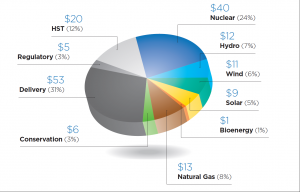By Jennifer Evola
The high cost of electricity has recently re-emerged as a hot-button issue in Ontario, with headlines like “Ontario electricity has never been cheaper, but bills have never been higher” and “Why does Ontario’s electricity cost so much?”. Premier Wynne has been called on to reduce ever-increasing electricity rates, among a slew of other hot political topics such as the Ontario cap-and-trade system and Toronto’s endless traffic issues.
We hear that our electricity costs are some of the highest in Canada and North America.
But what and who are to blame for Ontario’s high electricity prices?
Depending who you ask, the answer can be radically different. Often, to the dismay of the eco-conscious community, the Feed-In-Tariff (FIT) and Micro-FIT programs take the blame. Media attention to this argument seems to have increased around the same time as the Province implemented the Climate Change Mitigation and Low-Carbon Economy Act and Ontario’s 2016-2020 Climate Change Action Plan.
Others blame the debt retirement charge or the stranded debt of the former Ontario Hydro.
In full disclosure, I am not an expert, and I do not know exactly what has caused and continues to cause Ontario’s high electricity rates. But that’s just the point, it doesn’t really seem like there is much in the way of agreement as to what’s caused Ontario’s electricity price woes. One can see this simply through the links posted throughout this article. Odds are, a series of decisions with poor long-term outlook by multiple parties and administrations over a number of decades is really to blame.
But while I don’t have the key for Premier Wynne, some truths and some facts help shed light on the story.
First, renewable energy from solar and wind makes up 11% of Ontario’s generation capacity.

Electricity cost by generation type. Source: Environmental Defence, Backgrounder: Ontario's Electricity System (January 2017) .
According to a new report by Environmental Defence, while FIT and Micro-FIT contracts have been and continue to be above the reported average cost of all other forms of generation, they make up a miniscule part of Ontario’s electricity generation and therefore, your bill.
Second, nuclear generation is exceedingly expensive to build.
Where we may find fault with the Wynne government is in making the same mistakes of her predecessors, continuing reliance on costly forms of generation - namely the decisions made to back the refurbishment of Darlington Nuclear Generating Station, the prolonged closure of Pickering Generating Station and the Refurbishment of Bruce B Nuclear Generating Station. These are expensive. On the books, the Darlington and Bruce B refurbishments are estimated to cost $12.8 Billion and $13 Billion respectively; however, not a single nuclear project in Ontario has ever stayed remotely close to its budget, running on average 2.5x above budget.
Third, fossil fuel based generation forms are cheap to build and operate but have major external costs for taxpayers.
Ontario’s coal plants were cheap to build and operate, but the decision to close them was not only motivated by environmental concerns. Coal-fired generating stations caused more trips to the doctor or hospital and more days missed from work than any other form of generation. To be specific, research published in the Lancet linked coal-fired generation to a mortality rate of 24.5 deaths from acute or chronic effects per TWh; 298 cases of serious illness per TWh including respiratory, cerebrovascular hospital emissions, congestive heart failure and chronic bronchitis; and 17,676 cases of minor illness per TWh including restricted activity days, bronchodilator uses, coughs and lower-respiratory symptom days.
Fourth, the Global Adjustment is expensive.
What is the Global Adjustment? It is the difference between the wholesale price of electricity and the price actually paid by electricity consumers. According to Ontario's Independent Electricity System Operator (IESO),
"The Global Adjustment covers the cost of building new electricity infrastructure in the province, as well as providing conservation and demand response programs. It covers the difference between regulated rates to nuclear and large hydroelectric generators and the market price."
The Global Adjustment is calculated based on the difference between the Hourly Ontario Energy Price (basically, the wholesale market price), on one hand, and Ontario Power Generation’s regulated nuclear and hydro generation rates and contract prices paid to electricity generators and conservation suppliers, on the other.
The Global Adjustment has grown rapidly. Since 2011, it has been by far the biggest component of the total price of electricity. And what drives the Global Adjustment? Non-OPG natural gas and nuclear generation is the largest single component of the Global Adjustment.
Moving Forward
The answer to Ontario’s electricity bill costs might lie in all of the above. It’s likely that there are many sources and many issues to tackle if Ontario is to find a long-term solution to high electricity prices. The first step should be ensuring that Ontario does not continue to commit to high-cost electricity or promise quick fixes, while not addressing the root causes of electricity costs.
A diversified grid in which Ontario’s municipalities aren’t powered by a handful of large generating stations would be a start to reducing our electricity bills. Community energy planning should be the key to Ontario’s electricity grid of tomorrow. Why? In community energy planning, communities aren’t only consulted on the method of generation, they plan it. According to a report from Quality Urban Energy Systems of Tomorrow (QUEST) (a non-profit research and advocacy organization created by governments, utilities, energy companies and the real estate sector), community energy planning creates a future in which municipalities are in control of the method of generation and local jobs are created. These projects will not happen overnight, but are in line with Ontario’s Growth Plan for the Greater Golden Horseshoe and can contribute to achievement of Ontario’s greenhouse gas emissions reduction target through an emphasis on renewable energy. Community energy planning would also alleviate the issues previously seen with the implementation of the Green Energy Act, which was experienced as taking power away from communities.
Ontario can also look towards interim measures as a transition to a community-based electricity grid. We can import hydroelectricity from Québec, which could meet the demands of Ontario’s near-term generating needs.
Finding cheaper solutions to Ontario’s increasing energy needs is, however, only half the battle.
Conservation, not only in households but at the commercial and industrial levels, will also be key. This will not only save money but will contribute to the Province's fulfillment of its climate change reduction targets.
Ultimately, we shouldn’t be focused on the prices of today. Whatever solutions the Ontario government puts forward to lower electricity rates will be Band-Aid solutions. We should be talking about how to invest more wisely in the future.




